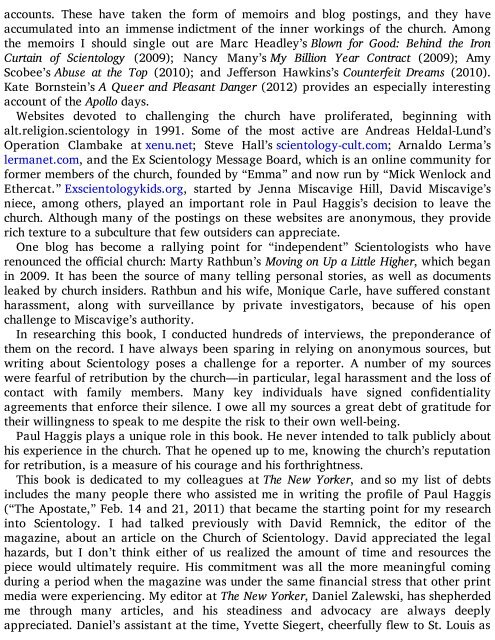going-clear-scientology-hollywood-and-the-prison-of-belief-by-lawrence-wright-2
going-clear-scientology-hollywood-and-the-prison-of-belief-by-lawrence-wright-2
going-clear-scientology-hollywood-and-the-prison-of-belief-by-lawrence-wright-2
Create successful ePaper yourself
Turn your PDF publications into a flip-book with our unique Google optimized e-Paper software.
accounts. These have taken <strong>the</strong> form <strong>of</strong> memoirs <strong>and</strong> blog postings, <strong>and</strong> <strong>the</strong>y have<br />
accumulated into an immense indictment <strong>of</strong> <strong>the</strong> inner workings <strong>of</strong> <strong>the</strong> church. Among<br />
<strong>the</strong> memoirs I should single out are Marc Headley’s Blown for Good: Behind <strong>the</strong> Iron<br />
Curtain <strong>of</strong> Scientology (2009); Nancy Many’s My Billion Year Contract (2009); Amy<br />
Scobee’s Abuse at <strong>the</strong> Top (2010); <strong>and</strong> Jeerson Hawkins’s Counterfeit Dreams (2010).<br />
Kate Bornstein’s A Queer <strong>and</strong> Pleasant Danger (2012) provides an especially interesting<br />
account <strong>of</strong> <strong>the</strong> Apollo days.<br />
Websites devoted to challenging <strong>the</strong> church have proliferated, beginning with<br />
alt.religion.<strong>scientology</strong> in 1991. Some <strong>of</strong> <strong>the</strong> most active are Andreas Heldal-Lund’s<br />
Operation Clambake at xenu.net; Steve Hall’s <strong>scientology</strong>-cult.com; Arnaldo Lerma’s<br />
lermanet.com, <strong>and</strong> <strong>the</strong> Ex Scientology Message Board, which is an online community for<br />
former members <strong>of</strong> <strong>the</strong> church, founded <strong>by</strong> “Emma” <strong>and</strong> now run <strong>by</strong> “Mick Wenlock <strong>and</strong><br />
E<strong>the</strong>rcat.” Ex<strong>scientology</strong>kids.org, started <strong>by</strong> Jenna Miscavige Hill, David Miscavige’s<br />
niece, among o<strong>the</strong>rs, played an important role in Paul Haggis’s decision to leave <strong>the</strong><br />
church. Although many <strong>of</strong> <strong>the</strong> postings on <strong>the</strong>se websites are anonymous, <strong>the</strong>y provide<br />
rich texture to a subculture that few outsiders can appreciate.<br />
One blog has become a rallying point for “independent” Scientologists who have<br />
renounced <strong>the</strong> ocial church: Marty Rathbun’s Moving on Up a Little Higher, which began<br />
in 2009. It has been <strong>the</strong> source <strong>of</strong> many telling personal stories, as well as documents<br />
leaked <strong>by</strong> church insiders. Rathbun <strong>and</strong> his wife, Monique Carle, have suered constant<br />
harassment, along with surveillance <strong>by</strong> private investigators, because <strong>of</strong> his open<br />
challenge to Miscavige’s authority.<br />
In researching this book, I conducted hundreds <strong>of</strong> interviews, <strong>the</strong> preponderance <strong>of</strong><br />
<strong>the</strong>m on <strong>the</strong> record. I have always been sparing in relying on anonymous sources, but<br />
writing about Scientology poses a challenge for a reporter. A number <strong>of</strong> my sources<br />
were fearful <strong>of</strong> retribution <strong>by</strong> <strong>the</strong> church—in particular, legal harassment <strong>and</strong> <strong>the</strong> loss <strong>of</strong><br />
contact with family members. Many key individuals have signed condentiality<br />
agreements that enforce <strong>the</strong>ir silence. I owe all my sources a great debt <strong>of</strong> gratitude for<br />
<strong>the</strong>ir willingness to speak to me despite <strong>the</strong> risk to <strong>the</strong>ir own well-being.<br />
Paul Haggis plays a unique role in this book. He never intended to talk publicly about<br />
his experience in <strong>the</strong> church. That he opened up to me, knowing <strong>the</strong> church’s reputation<br />
for retribution, is a measure <strong>of</strong> his courage <strong>and</strong> his forthrightness.<br />
This book is dedicated to my colleagues at The New Yorker, <strong>and</strong> so my list <strong>of</strong> debts<br />
includes <strong>the</strong> many people <strong>the</strong>re who assisted me in writing <strong>the</strong> prole <strong>of</strong> Paul Haggis<br />
(“The Apostate,” Feb. 14 <strong>and</strong> 21, 2011) that became <strong>the</strong> starting point for my research<br />
into Scientology. I had talked previously with David Remnick, <strong>the</strong> editor <strong>of</strong> <strong>the</strong><br />
magazine, about an article on <strong>the</strong> Church <strong>of</strong> Scientology. David appreciated <strong>the</strong> legal<br />
hazards, but I don’t think ei<strong>the</strong>r <strong>of</strong> us realized <strong>the</strong> amount <strong>of</strong> time <strong>and</strong> resources <strong>the</strong><br />
piece would ultimately require. His commitment was all <strong>the</strong> more meaningful coming<br />
during a period when <strong>the</strong> magazine was under <strong>the</strong> same nancial stress that o<strong>the</strong>r print<br />
media were experiencing. My editor at The New Yorker, Daniel Zalewski, has shepherded<br />
me through many articles, <strong>and</strong> his steadiness <strong>and</strong> advocacy are always deeply<br />
appreciated. Daniel’s assistant at <strong>the</strong> time, Yvette Siegert, cheerfully ew to St. Louis as


